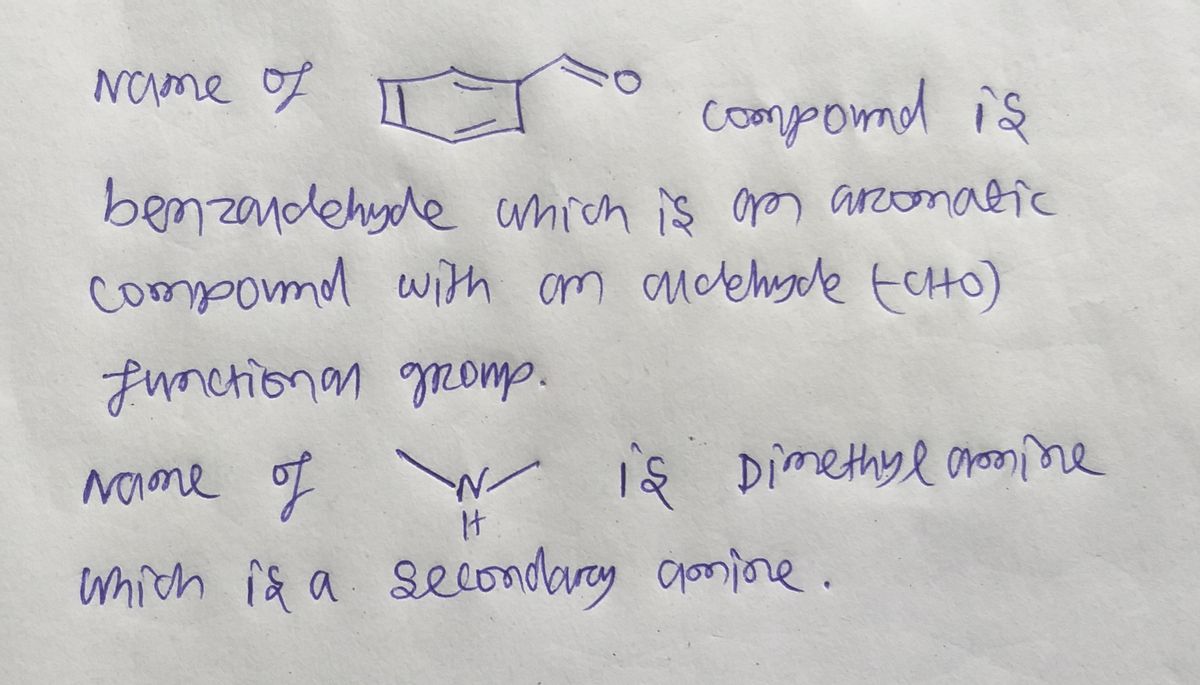Chemistry
10th Edition
ISBN:9781305957404
Author:Steven S. Zumdahl, Susan A. Zumdahl, Donald J. DeCoste
Publisher:Steven S. Zumdahl, Susan A. Zumdahl, Donald J. DeCoste
Chapter1: Chemical Foundations
Section: Chapter Questions
Problem 1RQ: Define and explain the differences between the following terms. a. law and theory b. theory and...
Related questions
Question

Transcribed Image Text:**Reaction Description:**
The task is to draw the major organic product for the given chemical reaction. The reaction involves a benzaldehyde (C6H5CHO) and a primary amine (represented by NH with R groups). The reaction conditions specify the presence of hydrochloric acid (HCl) as a catalyst.
**Diagram Explanation:**
1. **Reactants:**
- The structure on the left is a benzaldehyde, characterized by a phenyl ring (a hexagon with alternating double bonds) attached to a formyl group (C=O).
- The reactant on the right is a generic primary amine (RNH2), where R groups represent unknown or variable hydrocarbon chains.
2. **Reaction Conditions:**
- Hydrochloric acid (HCl) is specified as a catalyst. Catalysts accelerate the reaction without being consumed.
**Expected Reaction:**
The reaction likely involves the formation of an imine, where the carbonyl group (C=O) of benzaldehyde reacts with the amine group (NH2), resulting in the formation of a C=N bond while releasing water.
**General Outcome:**
- The major organic product is an imine with a phenyl group attached to the carbon of the imine group.
This kind of reaction is typically used to form C=N double bonds, important in many synthetic applications and biological systems.
Expert Solution
Step 1

Trending now
This is a popular solution!
Step by step
Solved in 2 steps with 2 images

Recommended textbooks for you

Chemistry
Chemistry
ISBN:
9781305957404
Author:
Steven S. Zumdahl, Susan A. Zumdahl, Donald J. DeCoste
Publisher:
Cengage Learning

Chemistry
Chemistry
ISBN:
9781259911156
Author:
Raymond Chang Dr., Jason Overby Professor
Publisher:
McGraw-Hill Education

Principles of Instrumental Analysis
Chemistry
ISBN:
9781305577213
Author:
Douglas A. Skoog, F. James Holler, Stanley R. Crouch
Publisher:
Cengage Learning

Chemistry
Chemistry
ISBN:
9781305957404
Author:
Steven S. Zumdahl, Susan A. Zumdahl, Donald J. DeCoste
Publisher:
Cengage Learning

Chemistry
Chemistry
ISBN:
9781259911156
Author:
Raymond Chang Dr., Jason Overby Professor
Publisher:
McGraw-Hill Education

Principles of Instrumental Analysis
Chemistry
ISBN:
9781305577213
Author:
Douglas A. Skoog, F. James Holler, Stanley R. Crouch
Publisher:
Cengage Learning

Organic Chemistry
Chemistry
ISBN:
9780078021558
Author:
Janice Gorzynski Smith Dr.
Publisher:
McGraw-Hill Education

Chemistry: Principles and Reactions
Chemistry
ISBN:
9781305079373
Author:
William L. Masterton, Cecile N. Hurley
Publisher:
Cengage Learning

Elementary Principles of Chemical Processes, Bind…
Chemistry
ISBN:
9781118431221
Author:
Richard M. Felder, Ronald W. Rousseau, Lisa G. Bullard
Publisher:
WILEY